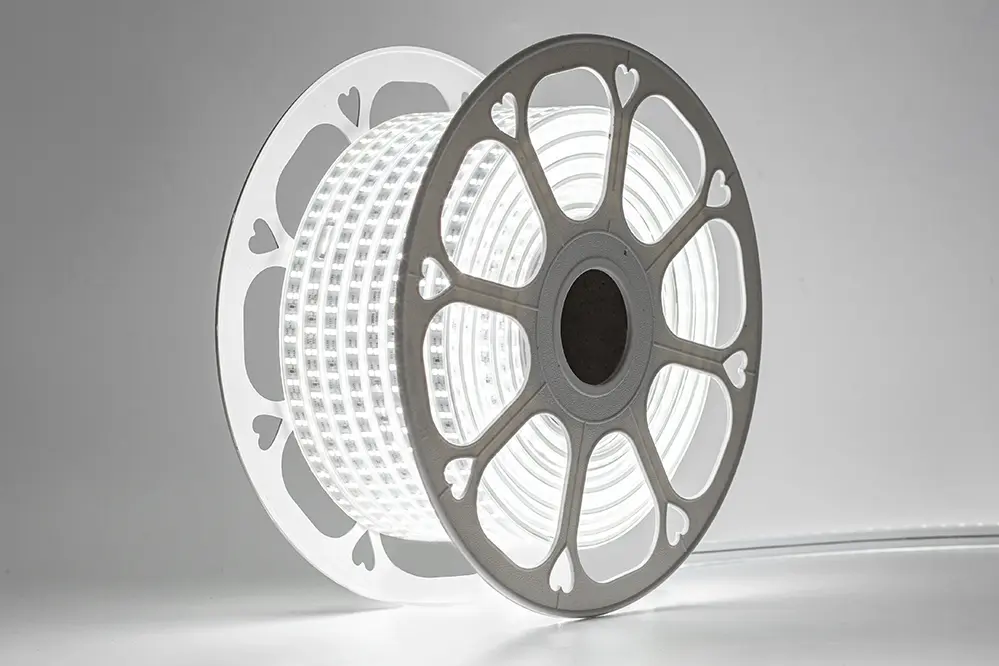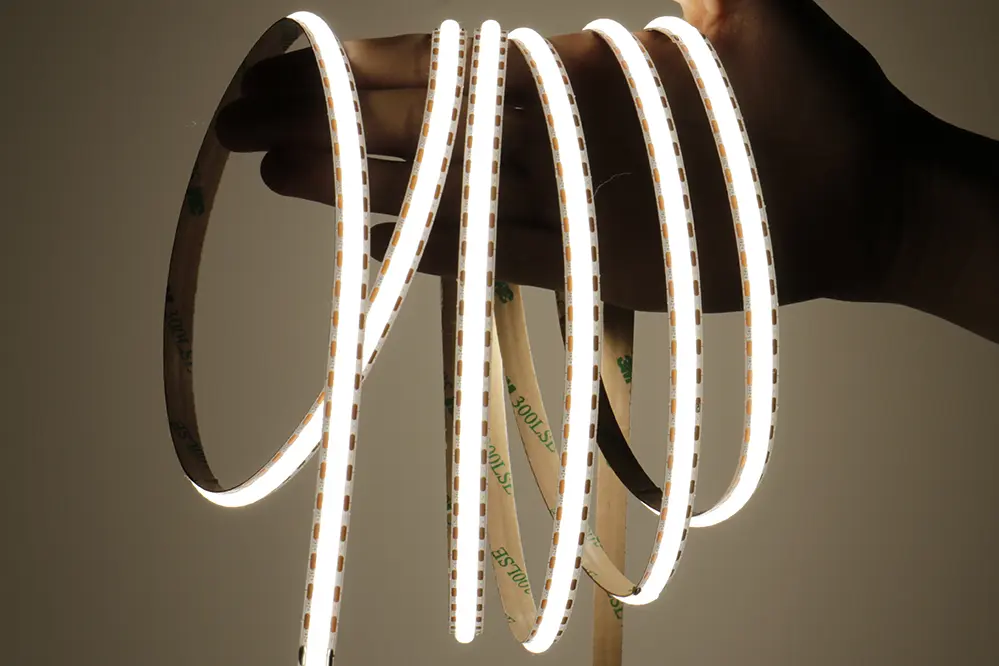Looking to enhance your space with LED strips but unsure if you can layer them? You’re in the right place. As an expert in lighting solutions, I have the insights you need to make an informed decision.
You can put LED strips on top of each other, but it requires careful consideration of heat dissipation, power supply, adhesion, and light diffusion to ensure optimal performance and longevity.
Curious to learn more about the best practices and potential pitfalls? Keep reading to discover how to achieve stunning lighting effects with layered LED strips.
Understanding LED Strips

LED strips are fascinating components that offer tremendous versatility for numerous applications, from home decor to advanced lighting projects.
They consist of small LEDs mounted on a flexible circuit board.
This flexibility allows you to shape, cut, and connect the strips in a variety of configurations, thus making them a popular choice among hobbyists, designers, and professionals.
LED strips come in different colors, brightness levels, and densities, enabling users to select a product that best fits their specific needs and aesthetic preferences. By understanding these options, you can unlock the full potential of LED technology in your projects.
How LED Strips Work
At their core, LED strips operate through the efficient use of light-emitting diodes (LEDs) soldered onto a flexible circuit board, which serves as the backbone facilitating electrical connectivity, heat dissipation, and structural support, highlighting the importance of soldering in their construction.
Electrically, these strips work by connecting to a power source, allowing them to connect efficiently and distribute power evenly.
When electricity flows through the circuit board, it energizes the diodes, causing them to emit light. The properties and distribution of these diodes contribute to the overall brightness and color of the strip.
Notably, LED strips also incorporate resistors to regulate current flow, ensuring each diode receives the optimal power level to function efficiently. This fine-tuning of current is crucial to maintain long-lasting performance and vibrant luminosity, whether for accent lighting or complex installations.
Can You Put LED Strips on Top of Each Other?
Can you put LED strips on top of each other for enhanced lighting effects or to fit specific design requirements?
In general, stacking LED strips directly on top of each other is not advisable. This practice can result in overheating.
When LED strips generate heat, it’s essential that they have sufficient ventilation. Overlapping strips restrict airflow and may damage the lights.
Spacing between strips is critical to prevent this issue. Ensure a gap of at least 3 mm, enabling proper heat dissipation, optimal performance, and extending their lifespan.
This technique helps maximize efficiency and fosters safe, innovative lighting solutions.
Safety Considerations
First and foremost, stacking LED strips poses a significant risk of overheating, which could potentially lead to malfunctions or damage.
Ensuring adequate ventilation around each strip is crucial.
Avoiding overlap reduces the risk of heat buildup, promoting longer-lasting performance and safety. Proper spacing and installation techniques will ensure your LED strips can function efficiently.
Additionally, adhering to the manufacturer’s guidelines is essential. They often provide specific recommendations for safe installation to prevent overheating and other issues. By following these instructions, you significantly minimize the likelihood of encountering problems. Safety should always be your top priority when installing LED strips.
Potential Risks of Stacking LED Strips
Stacking LED strips can cause overheating issues.
The overlapping of LED strips may obstruct efficient heat dissipation. The trapped heat can build up quickly and create an environment unfavorable for the LEDs, escalating the risk of damage or malfunction. Furthermore, excessive heat can shorten the lifespan of your LED strips significantly, making frequent replacements necessary.
This problem impacts the electrical components.
The heat generated by stacked LED strips can also affect adjacent components. This poses risks not only to the strips themselves but to other electronic devices nearby. Such overheating could potentially lead to electrical failures or hazards, contributing to unsafe conditions.
Physical damage can occur from overlapping.
LED strips are delicate, and placing one on top of another may exert undue pressure on them, potentially disrupting how they connect during soldering. This could result in bent or broken circuit connections, leading to inconsistent lighting performance, or even complete failure of portions of the strip.
Improve your setup by avoiding stacking.
By taking the time to install LED strips with proper spacing, you safeguard their functionality and longevity. Embracing best practices in installation can enhance the safety and effectiveness of your lighting solutions, maintaining the innovative edge you seek.
Methods to Safely Layer LED Strips
Layering LED strips can be advantageous, provided you adhere to specific precautions and methods.
Foremost, it’s crucial to use an electrical insulating material between the layers to prevent overheating and ensure optimal performance. Specialized thermal pads or tapes are designed to dissipate heat effectively, protecting both the LEDs and nearby electronic devices. By integrating these insulators, you can mitigate risks related to excessive heat buildup and potential electrical failures.
Additionally, proper spacing is essential to enhance ventilation. Opt for a structural framework that allows for slight gaps between the LED strips, ensuring adequate air circulation. This spacing not only preserves the integrity of the strips but also fortifies the longevity and reliability of your lighting setup.
Finally, invest in high-quality, flexible LED strips known for their durability and resilience. This will reduce the chances of physical damage when layering and maintain consistent lighting performance. These steps collectively pave the way for a secure and innovative multi-layer LED application, safeguarding both functionality and safety.
Considerations for Heat Management
Effective heat management is of paramount importance.
Achieving optimal thermal conditions is vital for your LED setup. When LEDs are painstakingly layered, the potential for heat concentration invariably escalates. Consequently, it is critical to ensure that heat dissipation mechanisms are robustly in place. Understanding the dynamics of thermal conductivity and implementing appropriate measures are foundational for a successful and safe installation.
Monitor thermal performance regularly.
By employing thermal conductive materials – such as specialized thermal pads or adhesive tapes – you not only enhance heat dispersion but also fortify the overall integrity of the LED assembly. Look for innovative solutions that seamlessly integrate with your design principles.
Additionally, consider active cooling mechanisms like miniature fans or heatsinks to reinforce passive cooling efforts. Such provisions establish a thermally optimal environment, ensuring peak performance and prolonged lifespan. Careful attention to these details unequivocally refines the utility and dependability of your LED configuration.
Tips for a Clean Installation
Creating a visually appealing installation requires thoughtful planning and precision. Proper organization is key to achieving an immaculate setup.
Measure the area meticulously to ensure your LED strips fit perfectly. This avoids the need for adjustments or re-alignments later on, streamlining the entire process.
Use high-quality adhesive backing to secure the LED strips. This guarantees firm attachment and prevents any sagging or misalignment over time, preserving the clean look.
Keep the wiring tidy by using cable management solutions. Cable ties or channels can be excellent for hiding wires, making the installation look professional and uncluttered.
Regularly check and maintain your LED setup, especially after initial installation. This ensures long-lasting performance and retains the pristine appearance of your arrangement.
Best Practices for Extended Longevity
To maximize the lifespan of your LED strips, proactive measures are essential.
Avoid placing LED strips on top of each other. This mitigates overheating issues.
Ensure adequate ventilation around the strips to disperse heat efficiently, which substantially prolongs their operational life. It’s prudent to install them on heat-dissipating surfaces, such as aluminum channels or profiles, to enhance cooling.
Incorporating a dimmer switch can significantly extend the LED strips’ longevity by reducing the load and heat generation. Regular monitoring for any signs of damage, such as discoloration or flickering, also enables timely interventions, ensuring a robust and enduring lighting solution.
Creative Applications of Layered LED Strips
For those daring to explore uncharted creative realms, layering LED strips unveils a realm of boundless potential, transforming mundane spaces into mesmerizing visual masterpieces.
Layered LED strips can amplify the intricacy and vibrancy of any lighting arrangement.
Imagine cascading hues smoothly transitioning from one strip to the next, creating an elegant spectrum of colors.
Moreover, interlaced patterns can add depth and dimension, significantly enhancing the visual appeal.
This technique can be particularly impactful in art installations or custom design projects, where the interplay of light and shadow brings the artwork to life in novel ways.
However, care must be taken to manage heat generation effectively. By combining aesthetic finesse with technical precision, layered LED strips can redefine what’s possible in lighting design.
Troubleshooting Common Issues
A smooth and seamless LED lighting experience calls for vigilance against common operational hiccups.
Intermittent flickering might indicate a loose connection.
Ensure that all connectors are firmly secured and that wiring follows professional standards, especially when soldering components to guarantee a secure connection. Overlapping layers can sometimes cause uneven lighting, shadows, or overheating, requiring careful alignment and heat management.
If you notice sporadic performance, consider adding a power supply with a higher wattage or adjusting the voltage settings. In any case, addressing these challenges with a methodical approach and consulting technical documentation can preserve the integrity of your layered LED setup. For lasting results, dedicated diagnosis and precise calibration are indispensable.
Final Thoughts on Layering LED Strips

Layering LED strips can be marvelous.
When executed meticulously, this method opens doors to stunning visual experiences. The sleek lines of light can enhance modern aesthetic foundations, while the adaptability allows for creative experimentation beyond conventional designs. However, it’s important to be mindful of potential challenges such as heat buildup and electrical load management.
Heat management is paramount.
Overlapping LED strips should be complemented with proper ventilation. This ensures the longevity and optimal performance of your lighting array.
By merging innovation with technical expertise, the possibilities become endless. As technology progresses and designs evolve, those willing to explore and harness the brilliance of layered LED strips will stay ahead of the curve. This approach offers an exciting frontier in the ever-expanding universe of lighting design.





